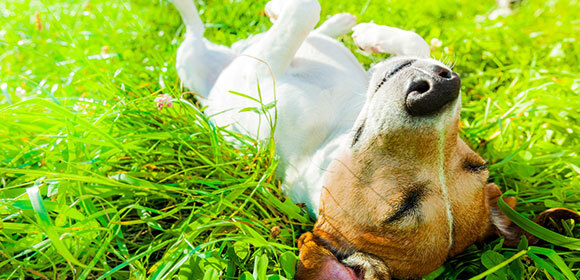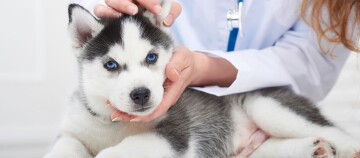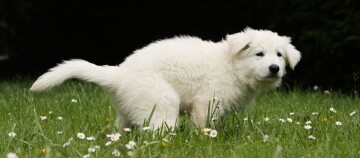Recognising Fleas and Grass Mites in a Dog – This Is What You Do!
20.03.2025 - Reading time: 9 minutes

Fleas and grass mites bite, suck, cause severe itching, red and raw spots on the skin, and localised hair loss in dogs. Unfortunately fleas can cause even more harm. Dogs that are heavily infested with these tiny bloodsuckers can even develop anaemia. By crunching and swallowing the fleas, your dog can become infected with tapeworms and swallowing fleas cause allergies. Read here to find out how you can quickly recognise and efficiently eradicate an infestation of fleas and grass mites!
- Understanding how an infestation of fleas occurs and how it progresses
- The spreading of fleas
- Beware of fleas in winter – tips to prevent flea infestation
- How to correctly identify fleas in your dog
- Put an end to the flea circus: effectively control and prevent fleas in dogs!
- First step: Eliminate the adult fleas and their brood
- Second step: Cull the flea brood from the environment
- Third step: Preventive measures
- Fleas transmit diseases – preventative measures you can take!
- Identifying and effectively combating grass mites in dogs
- Facts and information on the topic of fleas
- Facts and information on the subject of grass mites
Understanding how an infestation of fleas occurs and how it progresses
The main natural habitats for fleas include grass, meadows and bushes. Although this is where they “naturally” occur, they can also be found in very large numbers in homes and indoors. Here they wait for a suitable host to pass by before jumping onto it. These bloodsuckers, which are about 3 mm long, have an enormous jumping power of up to 1 m across and 25 cm high!
The flea is brownish in colour, its body is very narrow and flat, it has six legs and no wings, and is thus classified as a member of the insect family. Its prominent feature is its long, strong hind legs, which give it enormous jumping power. The flea’s body is made of chitin and this provides it with “armour” to protect it from its enemies.
Did you know that there are thousands of different flea species worldwide? The fleas of relevance to us include the dog flea (Ctenocephalides cani), cat flea (Ctenocephalides felis) and of course the human flea (Pulex irritans). Unfortunately, fleas do not abide by these designations, as the flea most commonly found on dogs is in fact the cat flea! Dog fleas, on the other hand, are actually quite rare.
When the infestation is very severe or the dog host is not present, dog and cat fleas can also very easily infest humans too. However, humans are not their first choice and merely serve as a so-called “false host” for a short period of time.
Fleas multiply and spread at a rapid rate
A female flea will lay her first eggs after her first blood meal. A single flea can lay between 27 and 50 eggs per day (on average) in the dog’s fur. The eggs are smooth and will eventually fall off the dog. They will lie in the grass or on your carpet and other home textiles until they have optimal conditions to hatch: a temperature of about 25°C and humidity of 80%. After about one week, the numerous larvae will hatch and given their sensitivity to light, will crawl into the sofa nooks or deep into your carpets, where they will pupate in a cocoon.
Their time will come after a minimum of 10 days. They recognise the right moment by the warmth, increase in CO2 and vibrations caused by their potential host. They will then hatch and jump out of their cocoon in one big leap and infest the dog, cat or human. Thus, the cycle starts all over again. Flea infestation can also occur when these parasites move freely from one dog to another. Nevertheless, since fleas are “attached” to their hosts, which ensure their survival, they seldom risk a leap into the “unknown”. The hedgehog is yet another host in our part of the world.
If initially there are just ten fleas on your dog, there may already be up to 500 eggs per day and a short time later larvae making themselves comfortable in your carpets, dog baskets, upholstery, pillows and textiles. Hatched larvae can survive there for up to six months without a blood meal.
In a home – more so where there are several animals – this can quickly lead to an invasion of fleas, which will then prove very difficult to contain. It is therefore better to take precautions in good time and act immediately in the event of a light flea infestation!
Beware of fleas in winter – tips to prevent flea infestation
Fleas seek the warmth of homes during the cold season and are transferred into cellars, attics or sheds by wild animals. Protect your dog against flea infestation even in the winter season! Natural spot-on preparations protect for up to four weeks, vermin tapes for about five months. A flea powder will clear your already infested dog of the annoying fur dwellers. It is also important to treat his surroundings, such as his sleeping area, with pest sprays to prevent the fleas from settling in further. A subsequent anthelmintic therapy for your dog is absolutely essential, because fleas can transmit worms. If the flea infestation is particularly persistent, a visit to the vet is essential. You can also find suitable products for protection against vermin here in the online shop.

Designpics/stock.adobe.com
How to correctly identify fleas in your dog
The first sign of a flea or mite infestation will be intense itching caused by the saliva of the biting and sucking flea, followed by your dog’s persistent scratching. Some dogs might also bite or nibble the flea-infested areas of their body.
Determining whether a dog is infested with fleas or grass mites is not always straightforward. Not every dog will scratch intensively or frequently enough for the dog owner to notice. Detecting fleas in thick fur is often a matter of luck. So if the initial infestation is minor, you may not even notice the uninvited pests – with the potentially fatal consequences of a subsequent flea invasion!
To find out if your dog has fleas, you can perform a simple test.
- You will need a so-called flea comb – a fine and close-meshed special comb – and a damp, light-coloured cloth or kitchen paper.
- Comb the dog’s coat against the direction of growth and then tap the comb on the damp cloth.
- Should you find black-brown particles, crush them on the damp cloth, or wipe the comb over the cloth.
- If the dark crumbs turn rusty brown to reddish or a red ring forms around the crumb, then this is the flea excrement (digested blood) that the fleas excrete after their blood meal. Incidentally, the flea larvae also feed on the faeces.
- If the dark particles do not change colour, then this is normal dirt from your dog’s coat.
Put an end to the flea circus: effectively control and prevent fleas in dogs!
By the time you notice a slight flea infestation on your dog, you can assume that there is already a massive infestation of fleas and larvae in the environment of your four-legged friend. Insect researchers assume that only 5% of fleas live on their host, the remaining 95% are distributed in the environment of the animal as eggs, larvae and pupae. This not only means that only a relatively small number of fleas can be found sucking blood on the dog, but also that the care of the dog’s environment is of the utmost importance.
Once there is a flea infestation, treating the dog with preparations designed for prevention, such as special collars and spot-on preparations, will not suffice. If they are used retrospectively, the fleas will leave your dog, but remain in the environment and infest your dog again at the next opportunity or make do with you as a false host.
First step: Eliminate the adult fleas and their brood
For this reason, in the case of an actual flea infestation, the only permanent solution to the flea problem is to use a highly effective preparation prescribed by a vet. On the one hand, this should be an insecticide that kills the adult fleas (special shampoos, flea powders, sprays). However, even the best insecticide will not kill all adult female fleas. Therefore, on the other hand, you should use an insect development inhibitor that destroys the eggs. In order to be effective, it is essential that the combination of the two preparations is applied repeatedly at the intervals specified by the manufacturer. It is vital to consult your vet, as these are toxic products. If there are other animals in your household, they must also be treated according to their species with other preparations if necessary!
Second step: Cull the flea brood from the environment
In order to finally break the cycle of the flea infestation, it is imperative for the entire environment of the animal to be flea free.
This can be achieved by strictly adhering to the following measures:
- Mop all floors and corners daily and vacuum all carpets and upholstery. Then remove the dust bag and dispose of it immediately. You can also add an anti-flea powder to the dust bag.
- If possible, wash dog blankets, basket pads, pillows/pillowcases frequently and dry clean sofa covers if necessary.
- Don’t forget your pet’s stuffed animals either.
- If your four-legged friend sleeps in your bed – and this cannot be avoided one hundred precent – it is essential to change the bed linen every day.
- Wash all textiles at a minimum of 60°C.
- Apply special anti-flea powder to your dog’s resting areas and textiles or an environmental spray from your vet, who will tell you how to use it (never use it on the dog!).
- These so-called flea foggers are room sprays that kill fleas, eggs as well as larvae. They are placed in the living space and switch on automatically. During this time, you and all pets should leave the room/home for at least two hours and then air the room/your home thoroughly. Foggers should be used in the case of a heavy infestation.
- Remember to “smoke out” the garage, car, storerooms, etc. in the same way.
Be sure to continue for three months so that the eggs and larvae don’t stand a chance either!
Third step: Preventive measures
Only a close-meshed prophylaxis will save you these costly and time-consuming measures to combat a heavy flea infestation. For this reason, it is even more important to start administering special antiparasitics such as spot-on preparations or flea dog collars in parallel with the flea cure. But the best option is an antiparasitic with a repellent (deterrent) or so-called knock-down effect, to prevent the flea from biting in the first place. This effect is especially important in the case of dogs with allergies to flea saliva. The drug of choice should ideally be fast-acting and, as far as possible, gentle on the dog.
Seek advice from your vet as these too are toxic insecticides.
Fleas transmit diseases – preventative measures you can take!
Fleas are infected with the cucumber tapeworm (Dipylidium caninum) and transmit it when bitten or swallowed by the dog. Therefore, a worming treatment is indispensable after the flea treatment!
The fleas’ saliva, which enters the dog’s organism during a blood meal, can cause a serious allergy in some dogs – especially if the flea infestation is extensive – this is referred to as flea dermatitis.
The symptoms of a flea or grass mite allergy can be:
- Frequent and severe scratching and self-biting
- Raw areas of the skin and blisters
- Hair loss on the back of the back, hind legs or base of the tail
- Redness and skin changes such as the so-called “hot spots” (hot, red areas of skin), especially at the base of the back and the inner sides of the thighs/back legs
- Red puncture marks surrounded by a reddened halo
- In extreme cases: change of character (nervousness, anxiety, aggressiveness) triggered by excruciating itching and painful inflammation
Treatment for a flea and mite allergy:
The first priority is to control fleas and mites on the dog and in its environment using special medication from the vet.
Prophylaxis with spot-on preparations or flea collars are only effective if these products contain a repellent effect.
Identifying and effectively combating grass mites in dogs
It is the larvae of the grass mite, also called the harvest mite, that cause problems for dogs as well as humans. Grass mites are barely visible to the human eye, as they are only about 0.3 mm big. Nevertheless, their orange-red body makes them much easier to spot.
Grass mite larvae appear from March at the earliest and – as their name suggests – like to sit in grass, grass bales or even in straw or knee-high plants. If you want to find out whether these pests have taken up residence in your garden, place a light-coloured cloth on the lawn in summer, where the grass mites will quickly gather to sunbathe.
They affect the parts of the dog’s body that come into contact with the grass: paws, head, ears, legs, belly and chest. The mites mainly seek out areas where the skin is thinner, scratch the skin and release a salivary secretion.
A simple test for detecting grass mites in dogs:
- Place your dog on a white cloth and brush it with a flea comb in the same way as for the flea test.
- You may notice red spots in the coat while brushing. Otherwise, tap the comb on the cloth where the red spots will be more visible.
Just like the saliva of fleas, the saliva of the grass mite larvae triggers a potentially very strong itch. The grass mite is not a bloodsucker, but prefers cellular and lymphatic fluids. It does not transmit any diseases, but it is equally unpleasant for dogs and people because it can cause trombidiasis in people and mite allergies in dogs. The powerful itching intensifies with scratching and warmth.
For that reason it is important to prevent an infestation with grass mites and, in acute cases, to act quickly and effectively, because the bite sites become infected quickly and can result in sequelae.
Although simple treatment methods are available, up until now there have been no effective means of prevention, such as repellents.
The following measures are the most usual:
- During the mite season, change the route of your daily walk in order to use more paved paths.
- After walking in fields, thoroughly spray off affected areas or the entire dog with water.
- To treat the itching, a “paw bath” made of curd soap and warm water can help. Afterwards you should thoroughly rinse your dog’s paws.
- Olive oil, apple cider vinegar, a weak (!) alcohol solution and salt water should all be equally helpful as home remedies to relieve the torturous itching. You should also lightly disinfect the area.
- If the whole body is affected, you should bath the dog.
- Rub the bite sites with disinfectant and an anti-itch salve.
- Cut your lawn frequently and treat it with a mixture of stinging nettles (effectively kills the larvae). Then immediately dispose of the cuttings.
- Clean the floor of your living area thoroughly with water and hoover or wash your dog’s bed.
- In the case of severe or frequent infestations, and for mite allergies, ask your vet about appropriate treatments for your dog.


